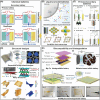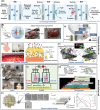Biomimetic Exogenous "Tissue Batteries" as Artificial Power Sources for Implantable Bioelectronic Devices Manufacturing
- PMID: 38196276
- PMCID: PMC10953594
- DOI: 10.1002/advs.202307369
Biomimetic Exogenous "Tissue Batteries" as Artificial Power Sources for Implantable Bioelectronic Devices Manufacturing
Abstract
Implantable bioelectronic devices (IBDs) have gained attention for their capacity to conformably detect physiological and pathological signals and further provide internal therapy. However, traditional power sources integrated into these IBDs possess intricate limitations such as bulkiness, rigidity, and biotoxicity. Recently, artificial "tissue batteries" (ATBs) have diffusely developed as artificial power sources for IBDs manufacturing, enabling comprehensive biological-activity monitoring, diagnosis, and therapy. ATBs are on-demand and designed to accommodate the soft and confining curved placement space of organisms, minimizing interface discrepancies, and providing ample power for clinical applications. This review presents the near-term advancements in ATBs, with a focus on their miniaturization, flexibility, biodegradability, and power density. Furthermore, it delves into material-screening, structural-design, and energy density across three distinct categories of TBs, distinguished by power supply strategies. These types encompass innovative energy storage devices (chemical batteries and supercapacitors), power conversion devices that harness power from human-body (biofuel cells, thermoelectric nanogenerators, bio-potential devices, piezoelectric harvesters, and triboelectric devices), and energy transfer devices that receive and utilize external energy (radiofrequency-ultrasound energy harvesters, ultrasound-induced energy harvesters, and photovoltaic devices). Ultimately, future challenges and prospects emphasize ATBs with the indispensability of bio-safety, flexibility, and high-volume energy density as crucial components in long-term implantable bioelectronic devices.
Keywords: artificial tissue batteries; implantable bioelectronic devices; implantable power sources.
© 2024 The Authors. Advanced Science published by Wiley-VCH GmbH.
Conflict of interest statement
The authors declare no conflict of interest.
Figures













Similar articles
-
Materials Strategies and Device Architectures of Emerging Power Supply Devices for Implantable Bioelectronics.Small. 2020 Apr;16(15):e1902827. doi: 10.1002/smll.201902827. Epub 2019 Sep 12. Small. 2020. PMID: 31513333 Review.
-
Advances in integrated power supplies for self-powered bioelectronic devices.Nanoscale. 2025 Jan 29;17(5):2423-2437. doi: 10.1039/d4nr04645e. Nanoscale. 2025. PMID: 39844771 Review.
-
Recent Advances of Energy Solutions for Implantable Bioelectronics.Adv Healthc Mater. 2021 Sep;10(17):e2100199. doi: 10.1002/adhm.202100199. Epub 2021 Apr 30. Adv Healthc Mater. 2021. PMID: 33930254 Review.
-
A comprehensive review of powering methods used in state-of-the-art miniaturized implantable electronic devices.Biosens Bioelectron. 2021 Jan 15;172:112781. doi: 10.1016/j.bios.2020.112781. Epub 2020 Oct 31. Biosens Bioelectron. 2021. PMID: 33160236 Review.
-
Piezoelectric nanogenerators for self-powered wearable and implantable bioelectronic devices.Acta Biomater. 2023 Nov;171:85-113. doi: 10.1016/j.actbio.2023.08.057. Epub 2023 Sep 4. Acta Biomater. 2023. PMID: 37673230 Review.
Cited by
-
Current Research Status and Future Trends of Vibration Energy Harvesters.Micromachines (Basel). 2024 Aug 30;15(9):1109. doi: 10.3390/mi15091109. Micromachines (Basel). 2024. PMID: 39337769 Free PMC article. Review.
-
Recent Advances in Enzymatic Biofuel Cells to Power Up Wearable and Implantable Biosensors.Biosensors (Basel). 2025 Mar 28;15(4):218. doi: 10.3390/bios15040218. Biosensors (Basel). 2025. PMID: 40277532 Free PMC article. Review.
References
-
- Reilly J. P., Applied bioelectricity: from electrical stimulation to electropathology, Springer Science & Business Media, New York: 2012.
-
- Winlow W., Johnson A. S., Bioelectricity 2021, 3, 161.
-
- Dai H., Chen Y., Dai W., Hu Z., Xie F., Xu W., Cui Z., Wei X., Chen Z., Yang B., Zhang W., Wei W., Guo R., Zhang G., Adv. Mater. Technol. 2021, 6, 2000848.
-
- Luo R., Dai J., Zhang J., Li Z., Adv. Healthcare Mater. 2021, 10, 2100557. - PubMed
-
- Sattar Y., Chhabra L., in StatPearls [Internet], StatPearls Publishing, 2022.
Publication types
MeSH terms
Grants and funding
- 2023M732159/China Postdoctoral Science Foundation
- 2022GY-272/Key R&D Program of Shaanxi Province
- 20200424/Young Talent Support Program Project of Shaanxi University Science and Technology Association
- 20200424/Youth and Middle-aged Scientific and Technological Innovation Leading Talents Program of the Corps
- 22308209/National Natural Science Foundation of China
LinkOut - more resources
Full Text Sources
